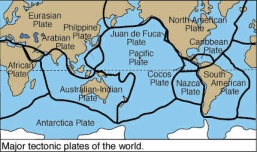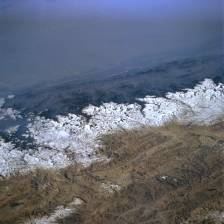Orders of ReliefThe topography of the Earth is a product of endogenic and exogenic processes. Relief is simply the difference in elevation between two points. When the surface is relatively flat we say it has low relief. Conversely, mountainous regions have high relief. The relief features of the earth are be divided into three orders based on what created them and their size. First Order Relief Features
First order relief features are the tectonic plates and are the largest in spatial extent. Two types of plates, continental and oceanic are differentiated by their rock and mineral composition. Continental plates are lighter in density and composed mostly of granitic rock material rich in silica and aluminum. The oceanic plates are made of dense, basaltic rock composed predominately of silica and magnesium. Second Order Relief FeaturesSecond order relief features are the result of plate collision or divergence. Rifts form where plates diverge from one another. If parallel rifting occurs, rift valleys, like the Great Rift Valley of Africa can form. Rifting can be accompanied by volcanic activity as magma pours out of the rift. Mt. Kilimanjaro was formed as a result of the rifting that created the Great Rift Valley of Africa.
Great mountain systems or trenches are created when plates converge. When two continental plates collide it causes the Earth to fold and buckle. Such is the case when the Indian Plate collided with the Eurasian Plate creating the Himalaya Mountains. Marine fossils are found at high altitudes where they were pushed up as a result of the collision. The presence of fossil marine organisms on high mountain peaks was used as evidence to support the theory of plate tectonics. Today, the uplift continues as the Indian Plate forces its way northward against the Eurasian, increasing the height of the world's tallest peaks. Extending from the northwest coast of the United States up along the Pacific Coast of Canada is the site where the Juan de la Fuca plate, an oceanic plate, is colliding with the North American plate, a continental plate. The denser and heavier oceanic plate dives beneath the lighter, less dense continental plate in a process of subduction. Subduction zones are noted for their frequent earthquake and volcanic activity. As the oceanic plate dives towards the interior of the earth the rock melts and some makes its way to the surface exploding with great fury to create spectacular volcanic cones. Third Order Relief FeaturesThird order relief features are for the most part created by erosion and deposition of the surface as opposed to the movement of tectonic plates. Individual landforms are considered third order relief features. There is no upper or lower limit to the size of third order relief features. One way to distinguish between second and third order relief features is one can see the entire form of third order feature but not a second. Figure 14. 8 Pawnee Cirque, Colorado Front Range, USA (Photo Courtesy M. Ritter) Pawnee cirque, the bowl shaped feature in the center of Figure 14.8 was caused by an alpine glacier eroding into the side of a mountain. The bowl-shaped depression left behind represents a third order relief feature of the earth. The picture was shot from across Isabelle Valley on Niwot Ridge. It is easy to see the full extent of the cirque but not the second order relief feature that it is located in, the Rocky Mountain system. The surface features studied by physical geographers are not only dependent on the various forces that create them, but the material composition of the Earth as well. The mineral content of rock, and the type of rock greatly effect their resistance to geological agents of erosion and hence the surface features of our planet. To understand the geographical variation of Earth surface features, we need a fundamental knowledge of the materials that comprise the Earth and their mode of origin. Assess your basic understanding of the preceding material by "Looking Back at Earth's Interior, Forces, and Orders of Relief" or continue reading. |

